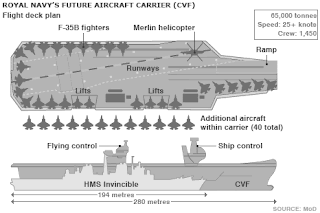-
New carriers at heart of defence debate
 A steel-cutting ceremony at Govan shipyard marks the beginning of construction of two new aircraft carriers, military vessels that stir emotions among supporters and opponents alike.
A steel-cutting ceremony at Govan shipyard marks the beginning of construction of two new aircraft carriers, military vessels that stir emotions among supporters and opponents alike.
What is it about aircraft carriers?
Of course they are big. And they are expensive. The latest estimate is that the Royal Navy's two new carriers, HMSs Queen Elizabeth and Prince of Wales, will cost £5bn - 25% up on just a year ago.
But it is not just that. Perhaps more than any weapons except nuclear ones, aircraft carriers tend to be seen as a statement of how a country views its military role in the world. And therein lies a lot of the controversy which seems to surround them.
The steel-cutting ceremony in Glasgow is certainly a historic event. It marks the formal start of construction of HMS Queen Elizabeth.
The last time that happened in Britain for a "proper" full-size aircraft carrier was 65 years ago. (The ship then was HMS Hermes, of Falklands fame, still serving now in the Indian Navy as the Viraat.)
But the carriers have also been at the heart of the arguments over the levels of and priorities in defence spending.
Continuing relevance?
Opponents, including some in the Army and the RAF, see them as expensive luxuries of little relevance to the kinds of campaigns Britain has been fighting in Iraq and Afghanistan.
They should, the argument goes, be sacrificed to pay for urgent shortfalls - in army equipment in particular.
Displacement: 65,000 tonnes
Length: 280m (920ft)
Width (at flight-deck level): 70m (230ft)
Keel to masthead: 56m (184ft)
Nine decks (plus flight deck)
Speed: 25+ knots
Range: 8,000-10,000 miles
Aircraft: 36 F-35 Joint Strike Fighters and four Airborne Early Warning aircraft, plus EH 101 Merlin helicopters
Crew: 1,450 (including air crew)
Weapons: Phalanx close-in weapon systems; 30mm and mini-guns
Source: Ministry of DefenceThe admirals, of course, disagree. They point out that the ships are designed to last for up to 50 years - and who knows what the threats will be then?
In that context, they insist, they are actually hugely flexible national assets - floating airfields that are not reliant on the goodwill of allies, that could help deter future conflicts, provide vital air support for troops ashore if they do occur again, and be able to perform a whole range of other missions - perhaps as huge helicopter platforms for some future humanitarian crisis.
But the £5bn price tag for the ships themselves is just the start.
There is also the question of the aircraft that they are chiefly designed to carry - the Joint Strike Fighters for both the Navy and the RAF, which will cost some £12bn.The commitment to the carriers was at the heart of Labour's 1998 Strategic Defence Review. But the sceptics say that the world has moved on.
And with commentators and the opposition both insisting that the Ministry of Defence's current plans are unsustainable, and that the state of the public finances means that there will have to be further savings in areas like defence, there have been growing calls for a new defence review, with these programmes very much in the spotlight.
Some argue that any such review also has to be in the context of a broader security review, beyond just defence, and a foreign policy re-think, that ask questions about whether the country can and should still try to project the kind of military power that the carriers imply.
There have been many echoes in the current debate from the 1960s, when the Navy last tried to win approval for a new class of big aircraft carriers.
The backdrop then was also that of an economic crisis, and questions over what level of international military footprint the country could afford.
There was a bitter inter-service fight between the Navy and the RAF. On that occasion, the Navy lost out. The then Labour government cancelled the carrier plans in 1966.
The Navy's consolation prize was a class of what were dubbed "through-deck cruisers", described as such in part to throw potential opponents off the scent that they were, in reality, mini-carriers.
The first, HMS Invincible, which also served in the Falklands and basically had to perform as a traditional carrier, is now in reserve. The other two, Illustrious and Ark Royal, soldier on for the time being.
Progress
The new carriers will be about three times the size of the current ships, and - at 65,000 tonnes - the largest British warships ever.
Britain's previous biggest carriers were HMS Eagle and the old Ark Royal, star of the Sailor television series in the mid-1970s, at 50,000 tonnes.
The plan is that the new ships will be built in blocks at four different shipyards, before being finally assembled at Rosyth. Officially, it has been stated that the construction programme will help create and sustain 10,000 jobs.
The only warships in the world that are significantly bigger are the US Navy's super-carriers, which weigh in at up to 100,000 tonnes. (They are nuclear-powered, and carry about 80 aircraft. HMS Queen Elizabeth and HMS Prince of Wales are designed to accommodate about 40.)
For the Navy, it has already been a tortuous process to get to this point with the new ships.
There are bound to be questions still about their future, against the current political and economic backdrop.
But, at least for the Navy, they have already progressed further than its last abortive big-carrier effort in the 1960s.












0 comments: